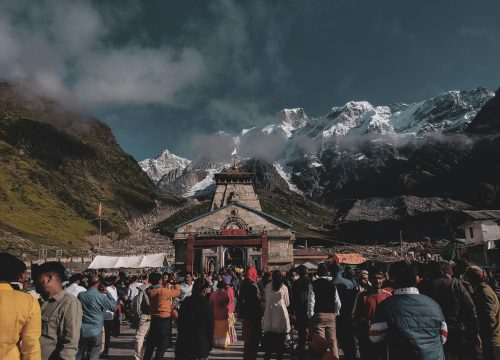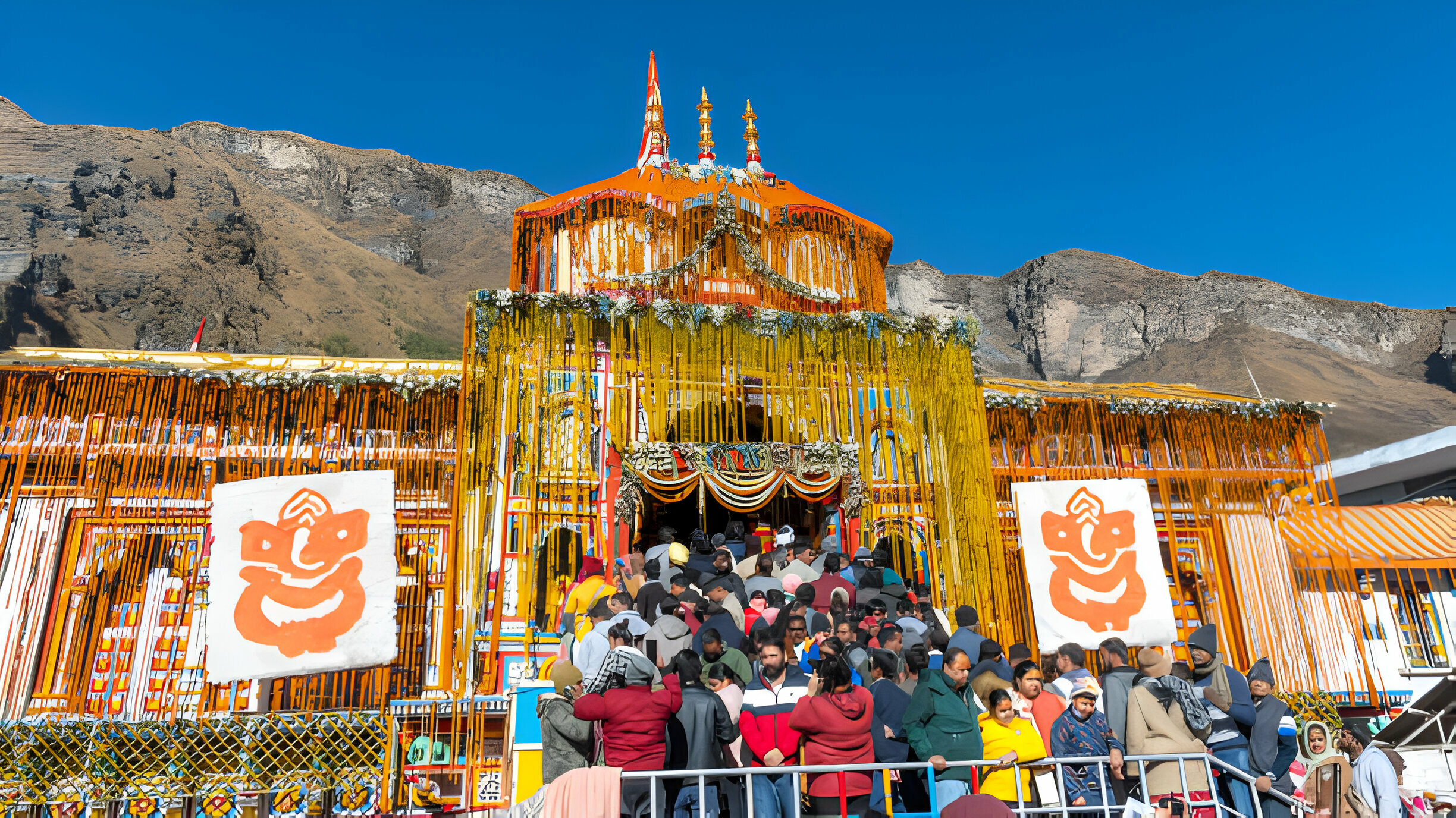Badrinath
- Home
- Badrinath
Badrinath Overview
:: Badrinath Dham ::
Badrinath Dham is one of the oldest of Hindu places of worship. On the right bank of the river Alaknanda lies the sacred shrine perched at an altitude of 3133 m above sea level, guarded on either side by the two mountain peaks Nar & Narain with the towering Neelkanth peak providing a splendid back-drop. Also known as the Vishal Badri, the largest among the five Badries, it is revered by all as the apt tribute to Lord Vishnu. he revered spot was once carpeted with wild berries which gave it the name ‘Badri Van’ meaning ‘forest of berries.’ Built by Adi Shankaracharaya, the philosopher-saint of the 8th century, the temple has been renovated several times due to damage by avalanches and restored in the 19th century by the royal houses of Scindia & Holkar. The main entrance gate is colorful & imposing popularly known as Singhdwar. References to Sri Badrinath have been made in the Vedas & perhaps it was a popular shrine during the Vedic age also. The Skanda Purana gives an accvount of the Adiguru consecrating the idol of Lord Badri Vishal in the temple after recovering it from Narad Kund, in a pursuance of a divine call from heaven.
Panch Badri: Badrinath is part of the Panch Badri pilgrimage circuit, which includes five sacred shrines dedicated to different forms of Lord Vishnu. The other four are Yogadhyan Badri, Bhavishya Badri, Adi Badri, and Vriddha Badri. Together, these temples form a significant religious circuit in Uttarakhand for devotees of Vishnu
Mana Village and Bhim Pul: As the last village on the Indian border, Mana Village holds great historical and mythological significance. The village is home to Bhim Pul, a large rock bridge over the Saraswati River, which is believed to have been placed by Bhim, one of the Pandavas. The village also features Vyas Gufa, where sage Vyasa is said to have composed the Mahabharata.
Surrounding Nature and Trekking: Badrinath is surrounded by breathtaking natural beauty, including snow-covered peaks, forests, and rivers. It is also a starting point for treks to scenic places like Satopanth Tal, a glacial lake surrounded by towering peaks.
Spiritual Significance: Badrinath is one of the Char Dham and Chhota Char Dham pilgrimage sites. It is dedicated to Lord Vishnu, who is worshipped here in the form of Badrinarayan. According to Hindu mythology, Adi Shankaracharya discovered the idol of Badrinarayan in the Alaknanda River and enshrined it in a cave near Tapt Kund. Later, a proper temple structure was built.
Best Time to Visit: The best time to visit Badrinath is between May and October, when the temple is open. The weather during this period is relatively pleasant, with temperatures ranging between 7°C and 18°C (45°F to 64°F). However, monsoons (July to September) can bring heavy rains and landslides, so caution is advised during this season.
Nearby Attractions
- Tapt Kund – A natural hot water spring near the temple.
- Mana Village – The last village of India near the Indo-Tibet border.
- Vyas Gufa – Believed to be the cave where Ved Vyas wrote the Mahabharata.
- Charan Paduka – A rock believed to have Lord Vishnu’s footprints.
- Neelkanth Peak – A stunning snow-covered mountain visible from the town.
Why Badrinath is Important?
Badrinath is the home of Lord Vishnu, who is worshipped here as Badrinarayan. It is believed that Lord Vishnu meditated here for thousands of years. This is why it is a very spiritual and peaceful place.
Travel Tips
- Wear warm clothes, even in summer.
- Carry medicines if you have breathing or heart problems.
- Walk slowly and drink water to avoid high-altitude sickness.
How to Reach Badrinath?
- By Air: Nearest airport is Jolly Grant (Dehradun) – about 310 km away.
- By Train: Nearest station is Rishikesh – about 295 km away.
- By Road: Badrinath is well connected by roads from Haridwar, Rishikesh, Dehradun, and Joshimath.
FAQ – Badrinath Dham
1. Where is Badrinath located?
Badrinath is located in Chamoli district, Uttarakhand, in the Garhwal Himalayas, near the Alaknanda River.
2. Which God is worshipped in Badrinath?
Lord Vishnu is worshipped here in the form of Badrinarayan.
3. Is Badrinath part of Char Dham?
Yes, Badrinath is one of the Char Dham and Chhota Char Dham pilgrimage sites in India.
4. What is the best time to visit Badrinath?
From May to October is the best time. Avoid the monsoon season (July–August) due to landslides.
5. When does the Badrinath Temple open and close?
The temple usually opens in April or May and closes in October or November, depending on the weather.
6. How can I reach Badrinath?
- By Air: Nearest airport is Jolly Grant, Dehradun (310 km).
- By Train: Nearest station is Rishikesh (295 km).
- By Road: Buses and taxis available from Haridwar, Rishikesh, and Joshimath.
7. Is there a risk of altitude sickness in Badrinath?
Yes, some visitors may feel breathless or dizzy due to high altitude. Drink water, walk slowly, and rest if needed.
8. Are hotels and food available in Badrinath?
Yes, there are many hotels, guest houses, and restaurants available for all budgets.
9. Can senior citizens or children visit Badrinath?
Yes, but it is advised to consult a doctor before traveling, especially for heart or breathing issues.
10. What clothes should I carry?
Always carry warm clothes, even in summer. In monsoon, carry rain protection like jackets or umbrellas.
More Information..
By Air:
Nearest Airport: Jolly Grant Airport, Dehradun (Approx. 310 km)
From the airport, you can take a taxi or bus to Rishikesh / Joshimath, then travel to Badrinath by road.
By Train:
Nearest Railway Station: Rishikesh (Approx. 295 km)
You can also come via Haridwar or Dehradun.
From the railway station, buses and taxis are available to Joshimath/Badrinath.
Badrinath is well connected by motorable roads from:
- Haridwar (316 km)
- Rishikesh (295 km)
- Dehradun (335 km)
- Joshimath (45 km)
Accordion Content
Places to visit nearby..
Locate on Map..
Send an Enquiry!
Send Enquiry !
last minute deals
Kedarnath Yatra 2024
Tour Theme
Recent posts
Our Facebook page
Tour Packages
- Quality4.77
- Location4.7
- Amenities4.57
- Services4.8
- Price4.6
Chardham Yatra Ex Delhi ( 11N -12D)
Featured Tour Packages
- Quality4.77
- Location4.7
- Amenities4.57
- Services4.8
- Price4.6













